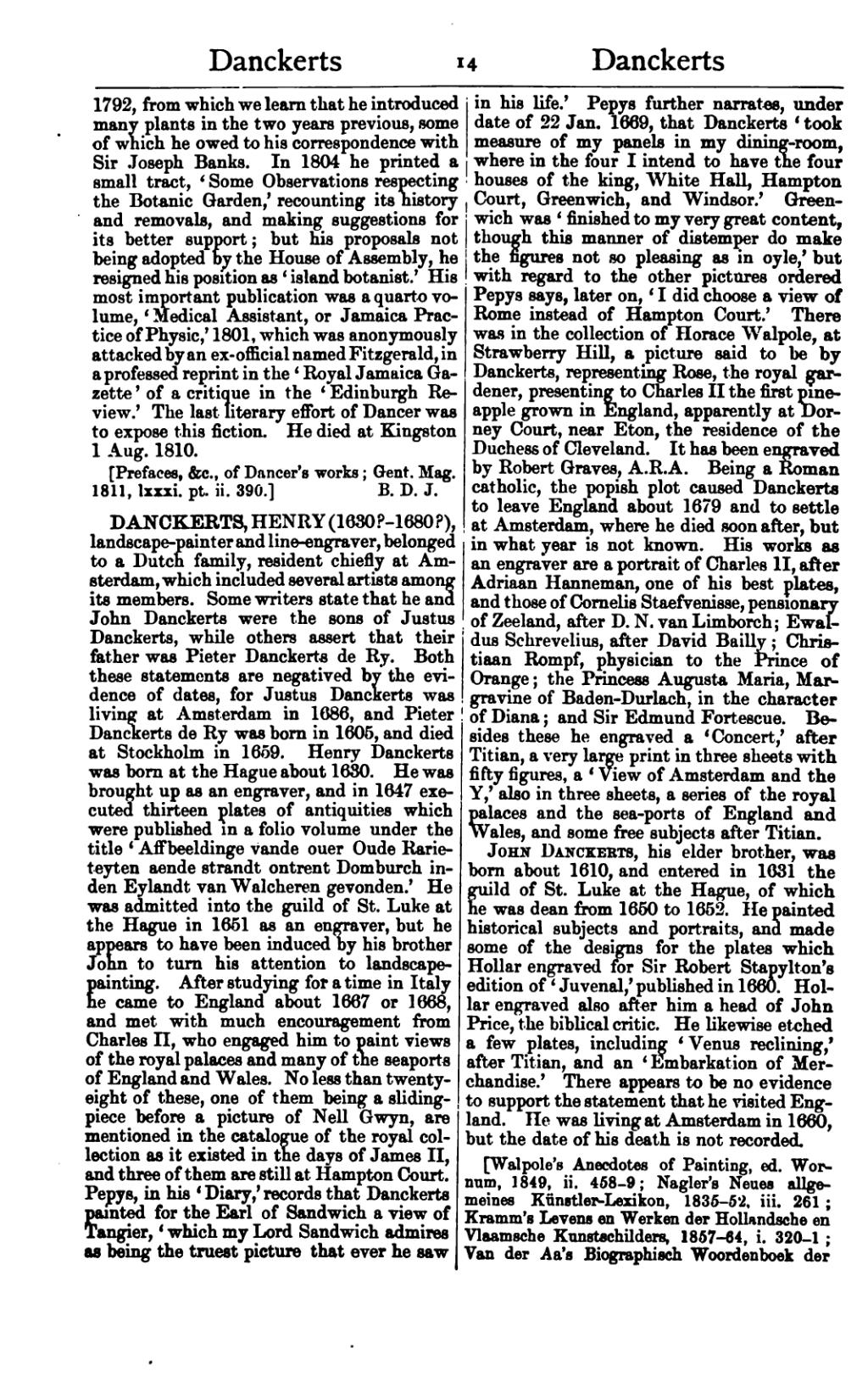1792, from which we learn that he introduced many plants in the two years previous, some of which he owed to his correspondence with Sir Joseph Banks. In 1804 he printed a small tract, ‘ Some Observations respecting the Botanic Garden,’ recounting its history and removals, and making suggestions for its better support; but his proposals not being adopted by the House of Assembly, he resigned his position as ‘island botanist.’ His most important publication was a quarto volume, ‘Medical Assistant, or Jamaica Practice of Physic,’ 1801, which was anonymously attacked by an ex-official named Fitzgerald, in a professed reprint in the ‘Royal Jamaica Gazette’ of a critique in the ‘Edinburgh Review.’ The last literary effort of Dancer was to expose this fiction. He died at Kingston 1 Aug. 1810.
[Prefaces, &c., of Dancer's works; Gent. Mag. 1811, lxxxi. pt. ii. 390.]
DANCKERTS, HENRY (1630?–1680?), landscape-painter and line-engraver, belonged to a Dutch family, resident chiefly at Amsterdam, which included several artists among its members. Some writers state that he and John Danckerts were the sons of Justus Danckerts, while others assert that their father was Pieter Danckerts de Ry. Both these statements are negatived by the evidence of dates, for Justus Danckerts was living at Amsterdam in 1686, and Pieter Danckerts de Ry was born in 1605, and died at Stockholm in 1659. Henry Danckerts was born at the Hague about 1630. He was brought up as an engraver, and in 1647 executed thirteen plates of antiquities which were published in a folio volume under the title ‘Affbeeldinge vande ouer Oude Rarieteyten aende strandt ontrent Domburch inden Eylandt van Walcheren gevonden.’ He was admitted into the guild of St. Luke at the Hague in 1651 as an engraver, but he appears to have been induced by his brother John to turn his attention to landscape-painting. After studying for a time in Italy he came to England about 1667 or 1668, and met with much encouragement from Charles II, who engaged him to paint views of the royal palaces and many of the seaports of England and Wales. No less than twenty-eight of these, one of them being a sliding-piece before a picture of Nell Gwyn, are mentioned in the catalogue of the royal collection as it existed in the days of James II, and three of them are still at Hampton Court. Pepys, in his ‘Diary,’ records that Danckerts painted for the Earl of Sandwich a view of Tangier, ‘which my Lord Sandwich admires as being the truest picture that ever he saw in his life.’ Pepys further narrates, under date of 22 Jan. 1669, that Danckerts ‘took measure of my panels in my dining-room, where in the four I intend to have the four houses of the king, White Hall, Hampton Court, Greenwich, and Windsor.’ Greenwich was ‘finished to my very great content, though this manner of distemper do make the figures not so pleasing as in oyle,’ but with regard to the other pictures ordered Pepys says, later on, ‘I did choose a view of Rome instead of Hampton Court.’ There was in the collection of Horace Walpole, at Strawberry Hill, a picture said to be by Danckerts, representing Rose, the royal gardener, presenting to Charles II the first pineapple grown in England, apparently at Dorney Court, near Eton, the residence of the Duchess of Cleveland. It has been engraved by Robert Graves, A.R.A. Being a Roman catholic, the popish plot caused Danckerts to leave England about 1679 and to settle at Amsterdam, where he died soon after, but in what year is not known. His works as an engraver are a portrait of Charles II, after Adriaan Hanneman, one of his best plates, and those of Cornelis Staefvenisse, pensionary of Zeeland, after D. N. van Limborch; Ewaldus Schrevelius, after David Bailly; Christiaan Rompf, physician to the Prince of Orange; the Princess Augusta Maria, Margravine of Baden-Durlach, in the character of Diana; and Sir Edmund Fortescue. Besides these he engraved a ‘Concert,’ after Titian, a very large print in three sheets with fifty figures, a ‘View of Amsterdam and the Y,’ also in three sheets, a series of the royal palaces and the sea-ports of England and Wales, and some free subjects after Titian.
John Danckerts, his elder brother, was born about 1610, and entered in 1631 the guild of St. Luke at the Hague, of which he was dean from 1650 to 1652. He painted historical subjects and portraits, and made some of the designs for the plates which Hollar engraved for Sir Robert Stapylton's edition of ‘Juvenal,’ published in 1660. Hollar engraved also after him a head of John Price, the biblical critic. He likewise etched a few plates, including ‘Venus reclining,’ after Titian, and an ‘Embarkation of Merchandise.’ There appears to be no evidence to support the statement that he visited England. He was living at Amsterdam in 1660, but the date of his death is not recorded.
[Walpole's Anecdotes of Painting, ed. Wornum, 1849, ii. 458–9; Nagler's Neues allgemeines Künstler-Lexikon, 1835–52, iii. 261; Kramm's Levens en Werken der Hollandsche en Vlaamsche Kunstschilders, 1857–64, i. 320–1; Van der Aa's Biographisch Woordenboek der
